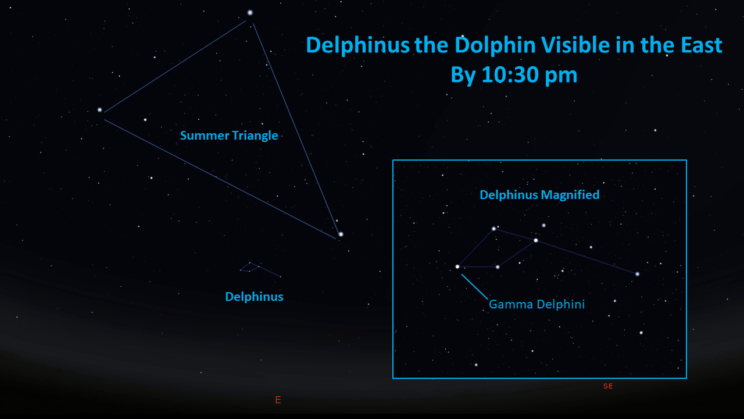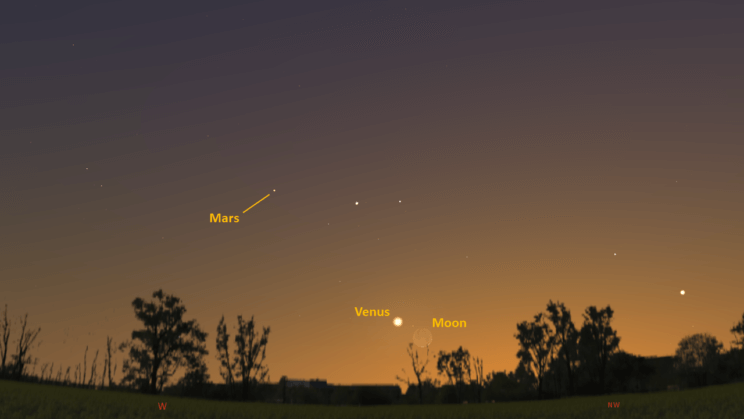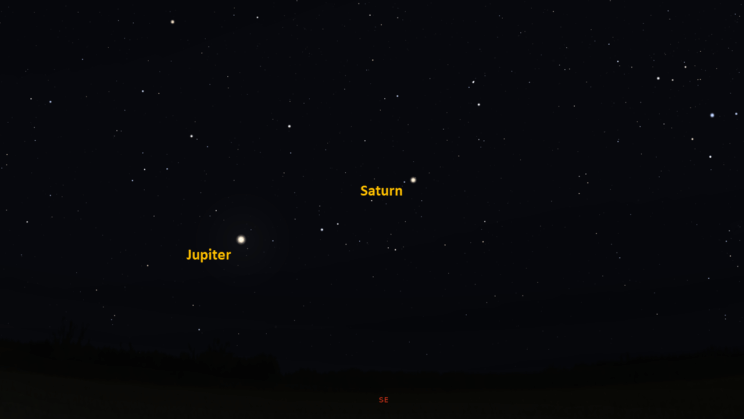This is the Saint Louis Science Center’s NIGHT SKY UPDATE for the week of Friday, June 11, 2021.
Information updated weekly or as needed.
Times given as local St. Louis time, which is Central Daylight Time (CDT). For definitions of terminology used in the night sky update, click the highlighted text. If relying on times posted in Universal Time (UT), St. Louis is -5 hours when CDT.
Public Telescope Viewings
With the changing recommendations from the CDC regarding COVID-19, conversations regarding the return of star parties at the Saint Louis Science Center have begun. We are close to bringing back our public telescope viewings, but a few details still need to be worked out. We will post future updates as we learn more about when we can bring back telescope viewings.
Observing Highlight of the Week

The Constellation Delphinus the Dolphin rising in the east at 10:30 pm
Credit: Stellarium, EG
This week we will visit another of the smaller constellations we can see this time of year. This constellation is known as Delphinus the Dolphin, ranked 69th in terms of size. The constellation is named after the dolphin from Greek legend that rescued the poet Arion, bringing him safely to the shores of Tarentum.
Delphinus is easy to find, owing to its location near the Summer Triangle. This famous summer asterism can be found rising in the east around 10:30 p.m. It is made up of the bright stars Deneb, Vega and Altair. To find Delphinus, look for the bright stars Deneb and Altair. Once you can find these, there will be a small diamond-shaped group of stars east of Altair. This is the constellation Delphinus.
The most striking object to look for in Delphinus is a double star called gamma Delphini. To the naked eye, this star marks the nose of the Dolphin with an apparent magnitude of 3.87. Once located, if you point a telescope at it, you will easily split Gamma Delphini into two stars. One will be a pale-yellow color, and the other is described as a greyish-lilac color. Gamma Delphini represents a proper double star with an orbital period of about 3,200 years.
Delphinus is often overlooked due to its proximity to brighter and bigger constellations, but it is worth a stop while you take in the rising summer sky.
The Sun and Moon

The Moon as seen from the International Space Station, on July 31, 2011.
Credit: NASA
Sunrise is at 5:36 a.m. on Friday, June 11, and sunset is at 8:26 p.m., providing us with nearly 15 hours of daylight. Even after sunset, the light from the Sun will dimly illuminate our sky for about 2 hours. This period is called twilight, which ends around 10:23 p.m. this week. For those with a sundial, local noon occurs around 1:01 p.m. this week.
| Day | Sunrise | Sunset |
|---|---|---|
| 2021-06-11 | 5:36 a.m. | 8:26 p.m. |
| 2021-06-12 | 5:36 a.m. | 8:26 p.m. |
| 2021-06-13 | 5:36 a.m. | 8:27 p.m. |
| 2021-06-14 | 5:36 a.m. | 8:27 p.m. |
| 2021-06-15 | 5:36 a.m. | 8:27 p.m. |
| 2021-06-16 | 5:36 a.m. | 8:28 p.m. |
| 2021-06-17 | 5:36 a.m. | 8:28 p.m. |
| 2021-06-18 | 5:36 a.m. | 8:28 p.m. |
| 2021-06-19 | 5:37 a.m. | 8:29 p.m. |
Moon
Moonrise for Friday, June 11 occurs at 6:21 a.m. and moonset will occur at 9:51 p.m. On Friday, June 11, the Moon will exhibit a waxing crescent phase with 2% of the lunar disk illuminated. First quarter moon occurs on June 17 at 10:54 p.m.
International Space Station (ISS) Observing

There are no visible passes of ISS for St. louis for the current week. Instead, this week we will post times for the new Chinese space station. Tianhe-1 can be seen in the morning hours over St. Louis this week. The best pass occurs on June 19. To learn more about this pass and others, use the table below.
Catch Tianhe-1 from St. Louis starting Friday, June 11
| Date | Starts | Max. altitude | Ends | |||||||
|---|---|---|---|---|---|---|---|---|---|---|
| Time | Alt. | Az. | Time | Alt. | Az. | Time | Alt. | Az. | ||
| 16 Jun | 3.6 | 04:47:41 | 10 | S | 04:49:17 | 13 | SE | 04:50:51 | 10 | ESE |
| 18 Jun | 2.7 | 04:22:29 | 16 | S | 04:23:58 | 22 | SSE | 04:26:31 | 10 | E |
| 19 Jun | 1.2 | 04:56:28 | 10 | WSW | 04:59:34 | 65 | SSE | 05:02:42 | 10 | ENE |
Magnitude (Mag): The Measure of brightness for a celestial object. The lower the value is, the brighter the object will be.
Altitude (Alt): The angle of a celestial object measured upwards from the observer’s horizon.
Azimuth (Az): The direction of a celestial object, measured clockwise from an observer’s location with north being 0°, east being 90°, south being 180° and west being 270°.
For information about ISS flyovers and other visible satellites, visit www.heavens-above.com
Detailed information regarding all unmanned exploration of our universe, missions past, present, and planned, can be found at Jet Propulsion Laboratories:
The Visible Planets

Looking West, at 9:00 pm, June 11, 2021
Credit: Stellarium, EG,

Looking Southeast, at 2:00 am, June 12, 2021
Credit: Stellarium, EG
This week, four naked eye planets are visible. Venus and Mars can be found in the west after sunset. Jupiter and Saturn can be found in the southeast before sunrise.
Venus
Venus is well into another evening apparition. By 8:45 p.m., Venus will be about 11° above the west-northwest horizon. As 2021 continues, we will see Venus climb higher in the western sky after sunset until October 29 when it reaches maximum eastern elongation. After this date Venus will start to head back towards the Sun as it approaches inferior conjunction on January 8, 2022.
Mars
Currently Mars appears as a 1.8-magnitude object that will be visible high in the west about 40 minutes after sunset. Mars sets by 11:02 p.m.
Jupiter
Jupiter is visible in the southeast before sunrise. Jupiter rises at 12:36 a.m. and will be easy to see in the southeast by 1:30 a.m.
Saturn
Saturn has returned to our morning sky. Saturn rises at 11:39 a.m. and will be easy to spot by 12:30 a.m. looking southeast.
James S. McDonnell Planetarium
Night Sky Update: June 11-June 19, 2021






